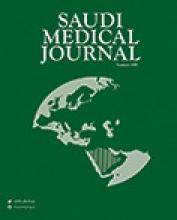Abstract
OBJECTIVE: The aim of this work is to evaluate treatment trends of cutaneous leishmaniasis (CL) in the Kingdom of Saudi Arabia (KSA), which is endemic according to the records of the Ministry of Health (MOH) and the World Health Organization (WHO) indicate so.
METHODS: A questionnaire was distributed to dermatologists and general practitioners working at health care centers in different parts of KSA through the Department of Preventive Medicine, Ministry of Health. This questionnaire consisted of 4 categories divided into 10 points covering the patients' demographics, severity of the disease, treatment types and regimen. The response of 107 physicians was included in this study, which covered the period from January-December 2000.
RESULTS: The responses of 107 physicians were accepted. Results indicated that there is no consistent method used in treating CL. There were disparities in the type and duration of treatment, in addition there were no differences between treatment of single and multiple lesions.
CONCLUSION: Guidelines for treatment of CL must be drawn and a nationwide policy should be implemented taking into consideration all factors that affect the outcome of treatment, such as the strain and susceptibility of the parasite, the severity of the disease as indicated by the size and number of lesions, as well as the patients characteristics such as age, nationality and immune system status.
- Copyright: © Saudi Medical Journal
This is an open-access article distributed under the terms of the Creative Commons Attribution-Noncommercial-Share Alike 3.0 Unported, which permits unrestricted use, distribution, and reproduction in any medium, provided the original work is properly cited.






